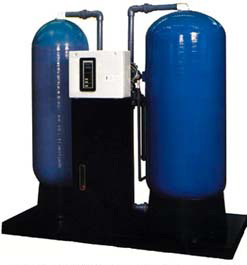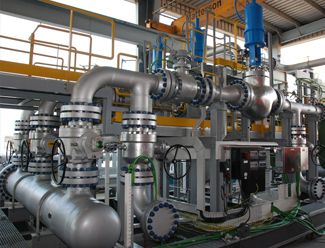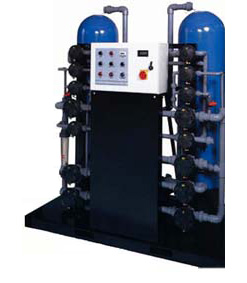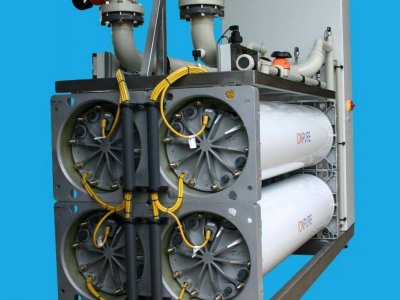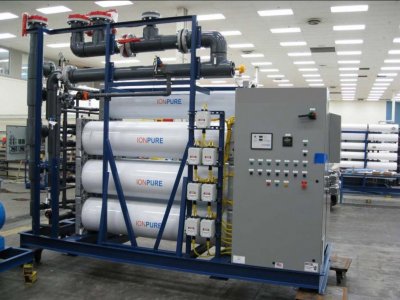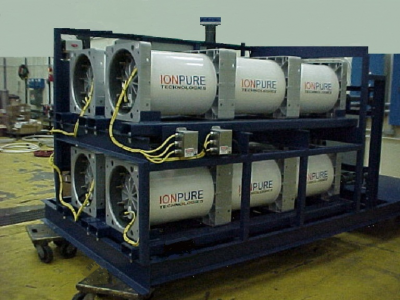Deionization plant
Designed for obtaining ultrapure water (up to 18.3 Mohm/cm), as well as for obtaining demineralized water from source water of low (up to 300 mg/l) and medium (up to 1500 mg/l) salinity.
The deionization process takes place on the surface of ion-exchange resins - cation exchange resin and anion exchange resin, with their subsequent regeneration with hydrochloric acid and sodium alkali solutions and neutralization of wastewater in foam scrubbers.
The source water must be preliminarily purified from suspended and colloidal contaminants, especially those of organic and silicate origin. The content of active chlorine should not exceed 0.1 mg/l.
The deionization process takes place on the surface of ion-exchange resins - cation exchange resin and anion exchange resin, with their subsequent regeneration with hydrochloric acid and sodium alkali solutions and neutralization of wastewater in foam scrubbers.
The source water must be preliminarily purified from suspended and colloidal contaminants, especially those of organic and silicate origin. The content of active chlorine should not exceed 0.1 mg/l.
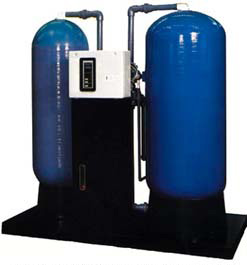
Separate action filters
Their characteristic difference is that the deionization process is carried out in two filtration columns - cation and anion. Our filters are equipped with built-in pumps for internal layer-by-layer recirculation of the treated water flow. Functionally divided into filters for receiving water:
-high purity;
-general purpose;
-allowing the content of CO2 and SiO2.
-high purity;
-general purpose;
-allowing the content of CO2 and SiO2.
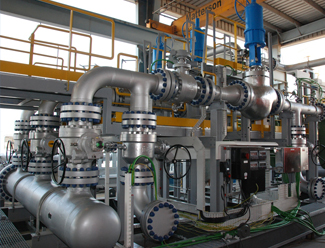
Mixed filters
Their characteristic difference is that a complete deionization cycle is carried out in one column, in a single-flow mode. The regeneration of the composition of ion-exchange resins is carried out automatically, including the preparation of appropriate eluent solutions. For a more complete regeneration, compressed air or nitrogen is used at a pressure of up to 1 atm. and consumption of 0.1 cubic meters / hour. The optimal pressure of the flow of treated water is 4.3 atm., the minimum pressure is 3.0 atm.
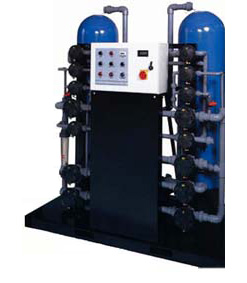 Separate action filters with accelerated regeneration. Our filters are distinguished by the fact that resin compositions are specially selected for them, and the regeneration cycle occurs simultaneously in countercurrent mode. A special pump provides effective accelerated regeneration - up to 30 minutes, at low flow rates. The inclusion of a foam scrubber-neutralizer in the installation ensures the neutralization of effluents to a pH value of 6–8. For more efficient operation of the unit, it is possible to supply compressed air or nitrogen with a pressure of 5.5 - 7.5 atm.
Separate action filters with accelerated regeneration. Our filters are distinguished by the fact that resin compositions are specially selected for them, and the regeneration cycle occurs simultaneously in countercurrent mode. A special pump provides effective accelerated regeneration - up to 30 minutes, at low flow rates. The inclusion of a foam scrubber-neutralizer in the installation ensures the neutralization of effluents to a pH value of 6–8. For more efficient operation of the unit, it is possible to supply compressed air or nitrogen with a pressure of 5.5 - 7.5 atm.Note: To ensure the operational stability of deionizer filters, it is desirable to have a standard external recirculation unit in production, consisting of a pressure tank and a booster pump.
Ion exchange columns for the production of 18-mohm water. Productivity is 20 m3/hour each. General Electric (GE)/Ionics customer. Operated at the Micron Technology factory, production of flash memory (Project completed jointly with CIT, USA). | Ion-exchange columns of mixed action. Productivity is 80 cubic meters/hour. IBM customer. (The project was carried out jointly with CIT, USA) |
Ion-exchange columns of mixed action. Productivity is 80 cubic meters/hour. General Electric (GE)/Ionics customer. Operated at the Micron Technology factory, the production of flash memory. (The project was carried out jointly with CIT, USA)
Continuous Electrodeionization Plants (CEDI)
New generation CEDIs are a combination of ion exchange, membrane technology and electrodialysis. The basic principle of CEDI is as follows: water is supplied to pressure channels formed by ion-selective membranes. The channel space is occupied by cation and anion resins. In the extreme channels there are electrodes - a cathode and an anode, which create a constant electric current. The combination of these processes ensures the continuous removal of dissolved salts and other charged particles. Concentrated salts enter the transmembrane zone of the pressure channel and are removed from it in the form of a concentrate stream. The flow ratio "filtrate - concentrate" is 95% to 5%. The average selectivity is 99.6%. This does not require the regeneration of ion exchange resins.
Here are the three sizes of CEDI units 40; 70 and 80 m3/h, equipped with VNX50HH-2 modules from Ion Pure, USA. These are cylindrical modules with high productivity: minimum - 4.5 m3/h, optimal -9.1 m3/h, maximum -11.2 m3/h.

CEDI 40 m3/h
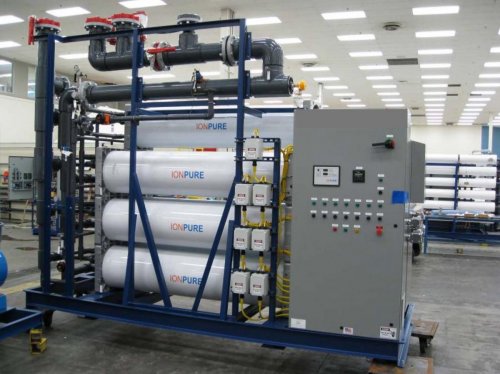 CEDI 70 m3/hour
CEDI 70 m3/hour CEDI 80 m3/h
CEDI 80 m3/hThis design of the module provides a more uniform distribution of water flow and electric field density in the pressure channels, which allows to increase its performance and service life.
Our Contacts
7072 Business Center, Al Shmookh Building UAQ Free Trade Zone, Umm Al Quwain, UAE

